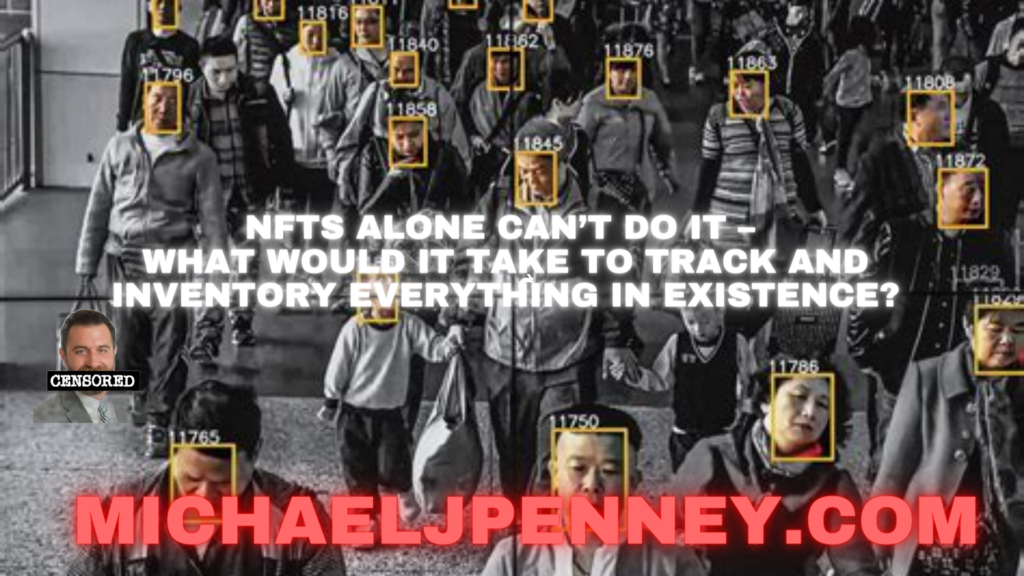NFTs (Non-Fungible Tokens) are unique digital assets that are stored on a blockchain, a distributed ledger technology that allows for secure and transparent recording of transactions. Unlike traditional cryptocurrencies such as Bitcoin or Ethereum, which are fungible (i.e., interchangeable with each other), NFTs are unique and cannot be exchanged for one another.
NFTs can represent a wide range of digital assets, such as artwork, music, videos, tweets, and even virtual real estate in online games. They are bought and sold using cryptocurrency, and ownership of an NFT is recorded on the blockchain. This allows for the creation of a verifiable, tamper-proof record of ownership, making NFTs a popular way to sell and collect digital art and other unique digital assets.
While NFTs can be used to represent and track ownership of unique digital assets, they may not be the best solution for inventorying everything in existence. A system of methods would have to be used.
Firstly, NFTs are designed for digital assets, not physical ones. While physical assets can be digitized and represented as NFTs, tracking physical assets in real life would require a physical system for tracking, such as RFID tags or barcodes.
Secondly, NFTs are not a perfect solution for inventorying even digital assets. While they can represent ownership, they do not provide a complete solution for tracking the lifecycle of a product or asset. For example, an NFT representing ownership of a digital artwork may not include information on the history of the artwork, its creator, or its previous owners.
While NFTs can be a powerful tool for tracking ownership of unique digital assets, they may not be the best solution for inventorying everything in existence, especially for physical assets. Other tracking and inventory management systems would likely be needed to provide a more complete solution.
There are a variety of systems that can be used for tracking and inventory management, depending on the specific needs of the organization or business.
A few examples are:
Barcode or RFID tracking: These systems use unique identifiers (such as barcodes or RFID tags) to track physical items. When an item is moved or used, its identifier is scanned and recorded, allowing for accurate tracking of its location and use.
Asset management software: Asset management software can help organizations keep track of their physical assets, including information such as the asset’s location, condition, and maintenance history.
Enterprise resource planning (ERP) systems: These systems are designed to manage the entire supply chain of a business, from procurement to production to distribution. They can help organizations keep track of inventory levels, monitor supplier performance, and optimize production processes.
Blockchain-based systems: While NFTs are one example of a blockchain-based tracking system, there are other blockchain-based systems that can be used for inventory management. These systems can provide secure, transparent tracking of assets and transactions, and can be used to ensure that items are authentic and have not been tampered with.
The specific system or combination of systems used will depend on the needs of the organization and the type of assets being tracked. Tracking and inventorying everything in existence would be an enormous task that would require a complex and multi-faceted system. It would involve tracking both physical and digital assets across a vast array of industries and domains.
Such a system would likely need to incorporate a combination of technologies and approaches, such as:
• A centralized database or distributed ledger system to store information about assets, transactions, and ownership.
• A global network of sensors, scanners, and other data-gathering devices to track physical assets and environmental conditions.
• A combination of human and artificial intelligence to manage the system, identify patterns and anomalies, and make decisions based on the data collected.
• A sophisticated set of algorithms and analytical tools to manage the vast amounts of data generated by the system, and to provide insights into the status and location of assets.
• Strong security protocols to protect against fraud, hacking, and other forms of attack.
Overall, the development of such a system would require significant resources, collaboration across multiple industries and domains, and a strong commitment to innovation and continuous improvement. While it may be possible to create such a system in the future, it would require a significant amount of time, effort, and investment.
LIVE AT 9-10 PM EASTERN – UNITED STATES OF AMERICA
+++++++++++++++++
Michael J. PENNEY aims to entertain, educate, and empower, you the LEADER… please leave your thoughts comments and corrections down below and be sure to hit the LIKE button… THANK YOU!
Personal Website: https://michaeljpenney.com/ [ Schedule a CALL with me ]
Biz Website: https://5paragraph.com/
Fiction Website: https://50wordshortstories.com/
GO LIVE with Streamyard: https://streamyard.com/pal/5172268461981696
Join Rumble: https://rumble.com/register/MichaelJPENNEY/
Rumble Channel: https://rumble.com/c/MichaelJPENNEY
+++++++++++++++++
Truth Social: https://truthsocial.com/@michaeljpenney
